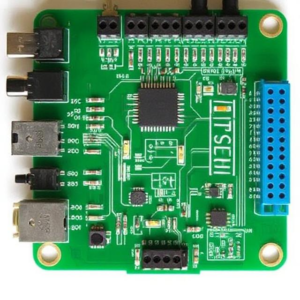1. Push Buttons
- What it is: A simple switch that you press to send an “on” or “off” signal.
- How it works: When you press a button, it either connects or disconnects an electrical circuit. This sends a signal to the device (like a microcontroller) saying “button pressed” or “button not pressed.”
- Common use: Turning something on or off, like a power button or a reset button.

2. Rotary Encoder
- What it is: A device that turns like a dial (think of adjusting volume on a speaker).
- How it works: It detects rotational movement and can track how much the dial has turned. It sends signals to a device that indicates the position or movement (turning left or right).
- Common use: Adjusting volume, changing settings, or controlling things like brightness on a screen.
3. Keypad (e.g., 4×4 Matrix)
- What it is: A set of buttons arranged in rows and columns (like a phone keypad).
- How it works: When you press a button, it sends a combination of row and column signals that correspond to a specific key. A 4×4 matrix means there are 4 rows and 4 columns, so 16 buttons in total.
- Common use: Entering numbers or letters, like on an ATM or entering a password.
4. Joystick Module
- What it is: A small device with a stick that you can move in different directions (like a game controller joystick).
- How it works: It uses sensors to detect how much you move the joystick along the X (left-right) and Y (up-down) axes. It sends the information to the device to tell it how far you moved.
- Common use: Video game controllers, controlling robots, or navigating menus.
5. Potentiometer (for analog input)
- What it is: A knob that you can turn to adjust something (like volume control).
- How it works: It adjusts the resistance inside it when you turn the knob. This change in resistance translates into a variable voltage that can be read by a device to know how much you’ve turned the knob.
- Common use: Adjusting volume, brightness, or any other setting that requires continuous input.
6. LCD/OLED Display (for showing data)
- What it is: A screen that displays text, numbers, or images (LCD is liquid crystal display, OLED is organic light-emitting diode).
- How it works: It takes input from a device (like a microcontroller) and shows information visually. For example, it can show numbers, time, or messages.
- Common use: Showing output like time, temperature, or any data in devices like clocks, calculators, or digital thermometers.
Tags: 4x4 matrix keypad, alphanumeric input, analog input, analog joystick, analog knob, analog sensor, analog voltage input, Arduino components, ATM keypad, brightness adjustment, brightness control, button matrix, button press detection, circuit control, cursor navigation, data visualization, dial sensor, digital display, digital encoder, digital input, digital keypad, directional control, display modules, DIY electronics, electrical switch, electronic modules, Embedded Systems, game controller, human-machine interface (HMI)., Input Devices, input matrix, input stick, interactive electronics, joystick module, joystick movement, keypad, knob rotation, LCD display, left-right rotation, liquid crystal display, message display, microcontroller components, microcontroller display, microcontroller input, momentary switch, numeric display, numerical input, OLED display, on/off signal, organic LED, output devices, password entry, position tracking, potentiometer, power button, prototyping components, push button, real-time feedback, reset button, resistance adjustment, robot control, rotary encoder, rotary input, rotary navigation, rotational movement, row-column detection, screen module, sensor interface, setting selector, tactile switch, text output, user entry device, user interface, user interface devices, variable resistor, visual output, Voltage Divider, volume control, XY axis sensor


